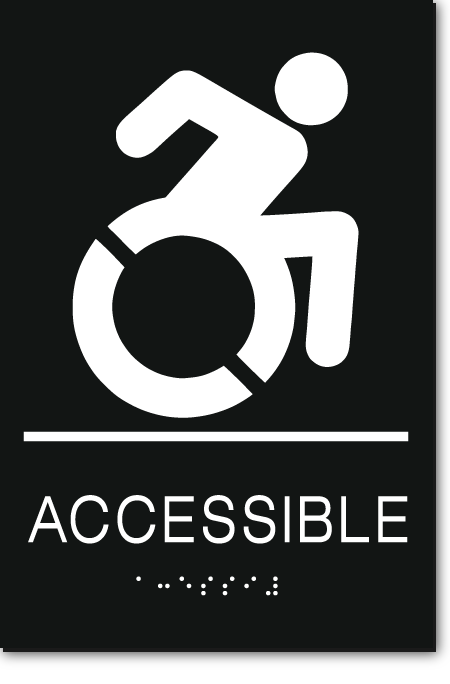Exploring the Key Functions of ADA Indicators for Boosted Ease Of Access
In the world of access, ADA indications offer as quiet yet powerful allies, making certain that areas are comprehensive and navigable for individuals with impairments. By incorporating Braille and tactile elements, these indicators damage obstacles for the visually damaged, while high-contrast shade plans and clear font styles cater to varied aesthetic demands.
Relevance of ADA Compliance
Guaranteeing conformity with the Americans with Disabilities Act (ADA) is critical for cultivating inclusivity and equal access in public rooms and offices. The ADA, passed in 1990, mandates that all public centers, companies, and transportation services fit individuals with handicaps, ensuring they enjoy the very same legal rights and chances as others. Conformity with ADA requirements not just meets legal obligations yet additionally improves a company's credibility by demonstrating its commitment to variety and inclusivity.
One of the essential aspects of ADA compliance is the implementation of obtainable signs. ADA signs are created to make sure that people with impairments can conveniently navigate with areas and buildings.
In addition, sticking to ADA guidelines can alleviate the risk of lawful repercussions and potential penalties. Organizations that fall short to adhere to ADA guidelines might encounter fines or claims, which can be both monetarily challenging and harmful to their public image. Thus, ADA compliance is integral to cultivating an equitable environment for everybody.
Braille and Tactile Elements
The consolidation of Braille and tactile elements right into ADA signs personifies the principles of ease of access and inclusivity. It is usually positioned beneath the corresponding message on signage to ensure that people can access the info without visual assistance.
Tactile components prolong beyond Braille and consist of elevated signs and personalities. These components are designed to be discernible by touch, enabling individuals to identify space numbers, toilets, departures, and various other vital locations. The ADA establishes specific standards relating to the size, spacing, and placement of these tactile elements to enhance readability and make sure uniformity across various settings.

High-Contrast Color Design
High-contrast color design play a pivotal role in enhancing the presence and readability of ADA signs for people with aesthetic impairments. These schemes are vital as they make best use of the difference in light reflectance in between message and background, ensuring that indicators are easily discernible, even from a distance. The Americans with Disabilities Act (ADA) mandates using particular shade contrasts to fit those with minimal vision, making it a critical aspect of conformity.
The efficiency of high-contrast shades depends on their click here now capacity to stick out in different lights conditions, including poorly lit atmospheres and areas with glow. Commonly, dark message on a light history or light text on a dark history is utilized to attain optimal contrast. As an example, black message on a yellow or white history gives a plain visual distinction that helps in fast acknowledgment and understanding.

Legible Fonts and Text Size
When taking into consideration the layout of ADA signs, the choice of understandable font styles and appropriate message dimension can not be overstated. The Americans with Disabilities Act (ADA) mandates that typefaces must be not italic and sans-serif, oblique, script, highly ornamental, or of unusual type.
The dimension of the text also plays a crucial role in accessibility. According to ADA guidelines, the minimum message elevation need to be 5/8 inch, and it ought to raise proportionally with viewing distance. This is specifically important in public spaces where signage needs to be checked out promptly and precisely. Consistency in text size adds to a cohesive aesthetic experience, helping people in browsing atmospheres effectively.
Furthermore, spacing between lines and letters is indispensable to legibility. Adequate spacing stops personalities from appearing crowded, boosting readability. By adhering to these standards, designers can dramatically improve ease of access, guaranteeing that signage offers its designated function for all individuals, no matter their aesthetic abilities.
Efficient Placement Methods
Strategic placement of ADA signs is important for making the most of important site access and making sure conformity with legal requirements. ADA standards stipulate that signs must be placed at a height between 48 to 60 inches from the ground to guarantee they are within the line of view for both standing and seated individuals.
Furthermore, indications have to be positioned adjacent to the lock side of doors to enable easy recognition before entrance. This placement assists people find areas and rooms without blockage. In instances where there is no door, indicators should be situated on the nearby surrounding wall surface. Uniformity in sign placement throughout a facility improves predictability, reducing confusion and boosting total customer experience.

Conclusion
ADA indications play a crucial function in promoting access by incorporating attributes that address the demands of people with disabilities. Integrating Braille and tactile components guarantees crucial information comes to the aesthetically damaged, while high-contrast color pattern and legible sans-serif font styles boost visibility throughout numerous lighting conditions. Reliable placement strategies, such as ideal mounting heights and calculated places, better promote navigation. These components jointly foster an inclusive environment, emphasizing the significance of ADA compliance in making sure wikipedia reference equivalent access for all.
In the realm of accessibility, ADA indications offer as silent yet powerful allies, guaranteeing that rooms are comprehensive and accessible for people with handicaps. The ADA, passed in 1990, mandates that all public facilities, companies, and transport services suit individuals with handicaps, guaranteeing they delight in the same legal rights and opportunities as others. ADA Signs. ADA indications are made to guarantee that people with handicaps can easily browse through buildings and spaces. ADA guidelines specify that signs should be mounted at an elevation in between 48 to 60 inches from the ground to guarantee they are within the line of sight for both standing and seated individuals.ADA indicators play an essential duty in advertising accessibility by integrating attributes that deal with the requirements of people with disabilities